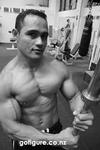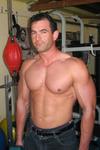| As much as I would love to say that the ultra-intense hardcore approach to bodybuilding combined with a “no limits” attitude and a long-held death wish is the best way forward, it is, once one has been in the personal training business for a while, apparent that such thinking is at best outdated, at worst precursory to dodgy training advice. Most people cannot maintain an extremely ripped, competition-ready physique for any longer than a week or two, maximum. An onstage physique - necessarily dehydrated and cut to shreds - may only be maintained in its present state - without water, sufficient calories and rest - for a few hours. But this is exactly the look many young guys want when they first enter a gym. The gorgeous girls and guys at the ProFormance CNI 2010 What many people do not realise, however, is the extreme training and dieting needed to get “ripped” and “sliced” beyond belief cannot be applied to those “merely” wanting to get into decent shape while gradually and realistically improving their muscle mass levels over time. One other thing to remember: once a bodybuilding competitor finishes a contest there is often a period during which they pack on a substantial amount of the wrong kind of weight (this is especially apparent during their “off-season”, the period throughout which they pack on “mass”). Such bodybuilders then begin to look more like a Dunkin Donuts representative than a muscle-loaded physique champion. How does this happen? The body, it appears, attempts to compensate for the starvation it has endured while dieting strictly and needlessly trudging through hour upon hour of cardio work and exceedingly hard weights sessions in preparation for the big event. Indeed, the body - upon stepping onstage - is likely to have reached a catabolic state, which can often only be rectified through a surplus of calories and much rest from the rigours of training. The off-season dilemma - what to eat, what not to eat - then ensues and our bodybuilder, unable to achieve a happy medium, finds themselves out of shape, the likely winner of “most abs” rather than “best abs”. Sensible bodybuilders, on the other hand, are aware that to maintain low body fat levels while increasing the body’s propensity for size building requires a more realistic approach, one that demands a less strenuous dietary and cardio regime.  Tony Ligaliga always look great all year round. Can extreme definition be attained without starvation diets and endless cardio and weight training? Not only can it be done, but it is, for most, an eminently more intelligent approach that will reward them with excellent size gains and a metabolism (the rate at which our bodies burn calories - specifically, for those reading this article, fat calories) that will continually burn excess weight, resulting in a low fat, muscular physique, which can, given the long-range approach taken, be maintained with relative ease. Provided below is a series of strategies that have helped me to achieve for my clients long lasting gains in size and muscular definition. They will help you too as you strive to build muscle sensibly.  So, the first step to creating a leaner physique all year ‘round is, it appears, to begin those workouts much earlier. Set the alarm (if so are so inclined to use this method), get your “250 pound three percent body fat MMA champion” physique out of bed and hit the weights before breakfast. You will get the testosterone boost of your life and grow like crazy; you will also no doubt feel more powerful throughout the day with all of that testosterone surging through your veins. Step three: Use cardio wisely  Muscle lost creates a lower metabolic rate; a lower metabolic rate means less fat burned at rest; less fat burned at rest means ‘goodbye lean physique.’ The key with cardio, as I have found, is to closely monitor your progress to determine whether you are continuing to build muscle while stripping fat. If so, great, but if you feel your strength/muscle gains are being compromised, reduce cardio activity until you find the perfect level needed to reach your goals. Remember, as bodybuilders/fitness enthusiasts it is important to place your health above all else. Excessive training is not only likely to overstress your body and negate your health and well-being, but also might have the reverse effect for which it was originally intended and may prevent fat loss. Short, sharp sessions that do not overly tax the muscles, yet stimulate them enough so as to create adaptation and further growth are far and away the better strategy compared with endless workouts which often do more harm than good. Muscle lost creates a lower metabolic rate; a lower metabolic rate means less fat burned at rest; less fat burned at rest means ‘goodbye lean physique.’ The key with cardio, as I have found, is to closely monitor your progress to determine whether you are continuing to build muscle while stripping fat. If so, great, but if you feel your strength/muscle gains are being compromised, reduce cardio activity until you find the perfect level needed to reach your goals. Remember, as bodybuilders/fitness enthusiasts it is important to place your health above all else. Excessive training is not only likely to overstress your body and negate your health and well-being, but also might have the reverse effect for which it was originally intended and may prevent fat loss. Short, sharp sessions that do not overly tax the muscles, yet stimulate them enough so as to create adaptation and further growth are far and away the better strategy compared with endless workouts which often do more harm than good. Components found in healthy fats can provide numerous benefits including the reduction of post-training inflammation, improved joint health and enhanced overall health and well-being. Fish oils, in particular, decrease body fat by driving down insulin levels. An anabolic hormone necessary for muscle growth and nutrient delivery to the muscle cells, insulin, when secreted in excess, can have its dangers: when we produce too much it, it tells your body to store more fat instead of burning unwanted weight as fuel.  Researchers Couet, Delarue, Ritz, Antoine & Lamisse (1997) (1) published a study in the International Journal of Obesity, which showed that those who supplemented their diet with omega-3 (an important essential fatty acid) - because of its role on moderating insulin levels among other factors - increased the number of fat calories burned per day by up to 26 percent. In fact, if excessive levels of insulin are rapidly released into the bloodstream, carbohydrates (if eaten in excess) are eventually converted into body fat. Maintaining a diet comprised of 10 to 15 percent healthy fats from a range of sources may not only help to reduce excessive insulin levels, but also help to optimize health to ensure our metabolism fires on all cylinders. About the author: Contact: This e-mail address is being protected from spambots. You need JavaScript enabled to view it |

The fitness site for today's active figures!
Monday, June 16, 2025


